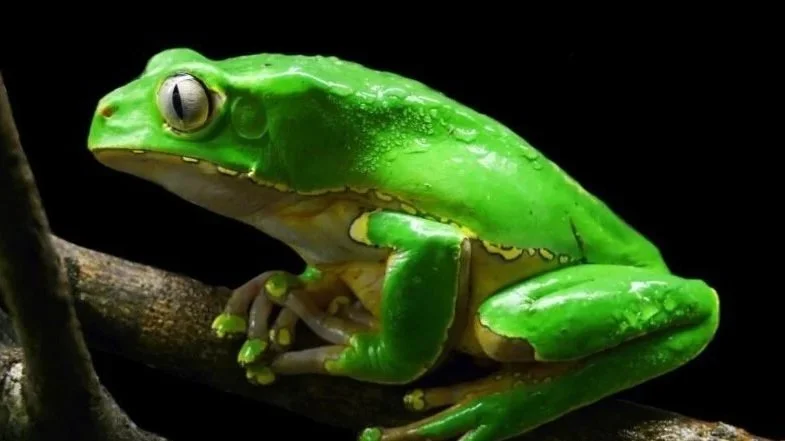
Tradition meets modern research
History of Kambo
Quick Overview
What it is
Kambo is the dried skin secretion of the giant leaf frog Phyllomedusa bicolor. It contains many small peptides that act on human biology.
Traditional use
Multiple Indigenous communities in the western Amazon use Kambo in ritual settings, often as a cleansing and fortifying practice tied to hunting and well-being.
What it feels like
Effects come on fast and are intense but brief. Common experiences include warmth or flushing, facial swelling, nausea, purge, sweat, and fatigue followed by a grounded, clear feeling.
How it is used
A practitioner places small “gates” on the skin, then applies a pea-sized amount of rehydrated secretion. A session is closely supervised and followed by rest and fluids.
Science snapshot
Researchers have isolated many peptides from Kambo, including dermorphins, deltorphins, tachykinins, bradykinin-like peptides, and antimicrobial peptides.
Safety first
Kambo is not a pharmaceutical drug and is not approved to treat medical conditions. Contraindications apply. Laws and guidance vary by country.
Quality and sourcing
Ethical practice respects the frog and its habitat, and uses traceable sticks, clean tools, and conservative dosing. The species ranges widely across the Amazon basin.
Aftercare
Hydrate, rest, and follow the practitioner’s guidance. Contact your practitioner if you feel unwell or have concerns after a session.
The Legend and History of Kambo Ceremony
Each tribe has its legend or story about how they came to use Kambo.
The most prevalent legend comes from Brazil. This Kaxinawá legend tells that the Indians of the tribe were very ill and their medicine man, the pajé, had done everything possible to cure them. All medicinal herbs known were used, but none helped. Under the effect of sacred plant medicines, he entered the forest and received a visit from a female spirit of the forest. She brought in her hands a frog, from which she took a white secretion and taught the pajé how to apply it. Returning to the tribe and following the guidelines he had received, the pajé cured his brothers and sisters. From then on, he was known as Pajé Kampu or Kampum. After his death, his spirit was said to live on in the frog, which continued its mission to protect the health of those who defend the forest.
The secretion became known as Kambo, but in some tribes it is called Sapo, Dow-Kiet, Kampu, or Vacina da Floresta. Usage spread, and for thousands of years it has been used by the Kaxinawá people and by many other Indigenous groups, including the Amahuaca, Katukina, Kulina, Yawanawá, Matses, Marubo, and Mayoruna. It is still used widely among Indigenous people in the Amazon today.
The first observations of Kambo use by an outsider were made by French priest Father Constantin Tastevin in 1925 while staying with the Kaxinawá in the upper Juruá River region of Brazil. In the 1980s, anthropologist Katherine Milton described use among the Mayoruna, and Peter Gorman wrote about his experiences taking sapo with the Matses in Peru.
During the 1990s, rubber tappers in Brazil learned about Kambo from Amazonian communities and began to bring it to towns in Acre. Having spent several years living with the Katukina, Francisco Gomes from Cruzeiro do Sul was one of the first to pioneer Kambo’s use outside the forest. Use then spread into larger Brazilian cities and internationally.
In 2004, Brazil’s health authority restricted advertising of medicinal and therapeutic claims for kambô in response to representation by Katukina leaders regarding intellectual property. Aside from this restriction, Kambo has been practiced in many places worldwide within varying local guidance.
The Science of It
Geek out on the science of peptides.
Twice nominated for a Nobel Prize and the person credited with first discovering serotonin, Italian scientist Vittorio Erspamer of the University of Rome was the first to analyze Kambo in a laboratory. In the 1980s he wrote that it contains a “fantastic chemical cocktail with potential medical applications, unequalled by any other amphibian.”
The chemicals he referred to are peptides. The peptides studied by Erspamer and others helped characterize the functional role of opioid receptors.
Several peptides have since been isolated from the secretion and several have been synthesized. There are many patents related to these peptides, largely filed by pharmaceutical companies.
As scientific interest grows, practitioners have also refined approaches that allow people to work with Kambo in ways that are accessible and carefully managed.
About Kambo
Kambo is a secretion from the Giant Green Monkey Tree Frog, known in science as the Phyllomedusa bicolor. The secretion is not a poison because it alone is not capable of causing illness, injury, or death.
In the Amazon, it is regarded as a medicine. This should not be confused with the Western definition of pharmaceutical medicine.
Those of us who give Kambo are practitioners, not doctors.
The Kambo frog has no natural predators and is found in abundance across the upper Amazon rainforest areas of Bolivia, Brazil, Colombia, Peru, French Guiana, Suriname, and Venezuela. The only known real threat to this frog species is the potential destruction of their habitat. These giant frogs reach up to 12 cm in length and reproduce throughout the year, mainly from November to May. They construct hanging nests from folded leaves 1 to 3 meters above ponds and streams. The females deposit a mass of eggs into these nests. A single spawn contains a thousand eggs on average, from which tadpoles emerge within 11 to 14 days.
No one is 100 percent certain what triggers production of the secretion, but it is widely believed to be sequestered from their diet.
The frogs do not produce their secretion when they are removed from their natural environment.
Neuro and Bio-Active Peptides in Kambo
-
Dermorphin
Short opioid peptide that binds mu-opioid receptors with very high potency in lab models.
Often described as many times more potent than morphine in vitro.
-
Deltorphin
Delta-selective opioid heptapeptides first isolated from Phyllomedusa.
High affinity for delta receptors in experiments.
-
Phyllomedusin
A tachykinin neuropeptide that activates NK1 receptors and strongly affects smooth muscle and secretory tissues in experiments.
Often linked to the purge response.
-
Phyllokinin
Bradykinin-like peptide reported to relax arterial smooth muscle and affect blood pressure in vitro.
-
Phyllocaerulein
Caerulein-like nonapeptide characterized from Phyllomedusa skin with actions similar to GI peptides in lab studies.
-
Adenoregulin
Amphiphilic 33-amino-acid peptide that can enhance agonist binding at adenosine A1 receptors in brain membrane assays.
-
Dermaseptins
Cationic antimicrobial peptides active against a range of microbes in vitro, with ongoing investigation into other properties.
-
Tryptophyllins
A diverse family of small tryptophan-containing peptides found in Phyllomedusa, studied for smooth-muscle and other bioactivities.
Research Timeline Highlights
1925: Father Constantin Tastevin records kambô among the Kaxinawá.
1980s: Vittorio Erspamer and others isolate and characterize multiple peptides.
1980s to 1990s: Reports and field notes from Katherine Milton and Peter Gorman.
1990s onward: Wider urban practice in Brazil and growing international interest.
2004: Brazil restricts advertising of medicinal and therapeutic claims for kambô.
Present: Ongoing lab studies of peptides and safety discussions in practice communities.
Modern Practice and Methods
Today there are a number of traditional approaches and contemporary methods. Practitioners still use classic point placements. Some schools also work with meridians, chakras, nadis, marma points, and even the ears in auricular Kambo. There are also gentler techniques that aim to reduce intensity while respecting the medicine.
About the Frog
Phyllomedusa bicolor is a large arboreal leaf frog that ranges across the Amazon Basin. It constructs folded-leaf nests above ponds and streams. The female deposits a mass of eggs into these nests. A single spawn averages about a thousand eggs, with tadpoles emerging within 11 to 14 days. Conservation concern focuses on habitat protection, not predators, since adults have few natural threats.
-
No. Kambo is not a classic psychedelic. Most effects are physical and intense for a short time.
-
Guidance varies by country and region. In Brazil, advertising therapeutic claims has been restricted since 2004. Check local laws where you live.
-
Ethical practice collects secretion without killing the frog and returns it to its habitat. Habitat loss is the larger conservation concern.
Next Steps
Safety & Contraindications
Add your pricing strategy. Be sure to include important details like value, length of service, and why it’s unique.
Request A Session
Add your pricing strategy. Be sure to include important details like value, length of service, and why it’s unique.










